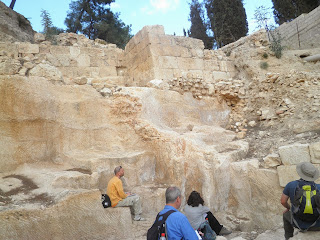I love asking people this question, and over the years, I've received some great answers. One of the popular responses from my Jewish friends is the Hasmonean Period in Jerusalem to be able to experience the miracle of Chanukah.
How appropriate then, that as Chanuka approaches, I spent the day exploring 2nd Temple Jerusalem.
Its amazing how much there is to see from this period.
The period spans a little more than 400 years. Starting with the return to Zion and the completion of the Second Temple in 350 BCE, it includes the times of the Persian Empire and the Jewish Hasmonean dynasty, and the Roman Empire, marked with King Herod's rule. Shorty after Herod renovates the Temple and it's plaza, Jerusalem and the Temple are destroyed in the year 70 CE.
The most well know site from this era is the Western Wall, the Kotel. Built toward the end of the Second Temple Period, the Western Wall is a retainer wall for the Temple Mount complex built by King Herod. The Western Wall stands 40 meters high from the street level and is 488 meters long. Built with stone hewed from quarries around the Jerusalem area, the largest stone in the Western Wall is 417 tons!!! For some comparison that is about 83 elephants worth of rock in one big stone, or 3 blue whales...wow, that sure is heavy!
But there is a lessor know section of the Temple Mount retainer walls that can be visited via entrance at the Davidson Center. This is the southern retainer wall, and today, I saw some pretty exciting remains from the Second Temple.
The original Shabbat Siren
A facsimile of an inscription found on street level. Originally located at the top of the wall, this inscription marked the spot that a trumpeter would sound his instrument as the Shabbat descended.
Ancient Market
If you think Machne Yehuda market is packed, add some live animals, and then you have the craziness of this market found at the base of the staircase leading up to the Temple Mount.
Pilgrim's Ascent
Three times a year, people would come from all over the country to bring sacrifices at the Temple. In order to control traffic, there was a separate staircase for people coming in and for people going out. Today we can walk up the exact same stairs that the Temple visitors walked up more than 2,000 years ago.
The stairs leading away from the Temple Mount are larger than average. One theory for why they were designed this way was to slow people down and to force them to leave the area with proper respect. There is no way to run down these stairs!
I am sure some people reading this post have visited the Old City of Jerusalem, perhaps many times. It amazes me that no matter how many times I am there, I can always see something I have never noticed before. Take this Hasmonean aqueduct. Can you figure out where this is?
If you guessed the staircase to the Kotel from the Jewish Quarter, you are right! Take a look below.
The engineers in Herod's employ were not the only brilliant workers. Check out the mosaics found in the excavated Kohanim (Priests) homes open to the public at the Herodian Quarter Museum. Notice that there are only geometric designs as Jews cannot make images of people. These are the oldest mosaics that have been found in Israel.
For those of you that would not pick Second Temple as your favorite period in History, don't worry! Check out these sites that have layers of different periods, one on top of the other.
City wall for added for protection
 |
The square stones wall on top is from the Byzantine period.
The square section on the lower right corner is Hasmonean (2nd Temple)
On top of the smooth part is a pile of rough rocks at the top left, that is the begining of the Temple One wall.
Why reinvent the wheel?
Outer wall of the City
Can you identify the different where one wall ends and the next begins?
As the sunsets over the city I can't help but feel lucky to live when and where I do. It is a city that mixes the ancient and contemporary with a beauty and a grace in a way that in uniquely Jerusalem.
Sunset from the top of the Tower of David.
When would you chose to live? Let me know if the comments section!
Join me tomorrow as I hike Shvil HaMaayan in the Aminadav Forest.
Until then...
~Rivi










No comments:
Post a Comment